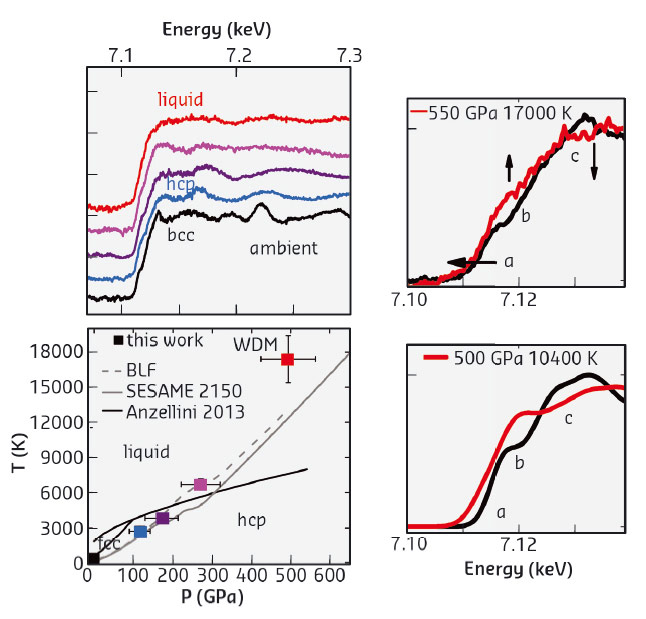- Home
- Users & Science
- Scientific Documentation
- ESRF Highlights
- ESRF Highlights 2016
- Matter at extremes
- Probing iron dynamically compressed to 500 GPa and 17000 K
Probing iron dynamically compressed to 500 GPa and 17000 K
We present data from a proof-of-principle experiment demonstrating that single pulse XAS synchrotron measurements enable the determination of structural and electronic properties of warm dense matter with accuracy close to that obtained for materials at ambient conditions. We show the first EXAFS data of Fe compressed to 500 GPa and heated to 17000 K. Our data indicate a persistent local order in the dense Fe fluid and stimulate further work to improve the electronic treatment of warm dense matter within the density functional theory.
Dynamic compression in the ns range obtained by direct laser ablation allows matter to be brought to very extreme states of pressure and temperature, well beyond the limit of static compression, to mimic the conditions of the interior of Earth and other planets. These are exotic states, like the warm dense matter (WDM) state, where conventional approximations used in condensed matter or plasma physics break down.
We present here a first feasibility test performed at the ESRF to investigate the local and electronic structure of warm and dense iron by coupling a 35 J portable laser to the energy dispersive X-ray absorption beamline ID24. In the direct laser ablation technique [1], a plasma is formed when the laser hits the target surface; a shock wave is created by the expansion and relaxation of the plasma and it propagates though the target causing it to reach very hot and dense states.
 |
|
Fig. 137: a) Schematic view of the experimental setup. b) Series of EXAFS spectra obtained by increasing the irradiation intensity. |
The sketch of the experimental configuration is presented in Figure 137a. The dispersive geometry of beamline ID24 allows the simultaneous collection of the whole XAS spectrum. Data were acquired using a single X-ray pulse of 100 ps duration, focused to 5 × 7 μm2 at the sample position. Laser pulses of energy < 35 J and duration ~ 10 ns impinged on the target with an angle of 30° and focal spot of 300 μm. The target was made of a thin (3.5 μm) deposit of pure Fe sandwiched between two diamond windows, which act to confine the shocked state over a time interval much longer than the 100 ps X-ray pulse.
The evolution of the K-edge EXAFS spectra at different pressures is shown in Figure 137b; the transition from cubic (bcc) to shock induced hexagonal (hcp) structure is clearly observed in the modifications of the spectra. The data quality allows EXAFS quantitative analysis to be performed, providing an estimate of the thermodynamic conditions (volume and temperature) directly from the data, which is a remarkable advantage of this technique.
 |
|
Fig. 138: Left top: a series of EXAFS spectra obtained in the highly-focused configuration of the laser. The P T conditions are indicated with the corresponding colours in the phase diagram (left bottom). Right: comparison between experimental and theoretical spectra of the K-edge of Fe. |
To reach more extreme conditions, the laser was focused to 90 μm. A new set of data was acquired (Figure 138, left panel): the compression and heating trend are revealed from the shift to higher energy and the broadening of the EXAFS oscillations respectively. As pressure increases, the bump in the edge starts to flatten, indicating the onset of melting. Remarkably, weak EXAFS oscillations remain as liquid Fe is further compressed and heated (500 GPa and 17000 K), indicating a persisting local order in the warm dense state.
Changes in the features of the absorption edge reflect the coupling between local order and the electronic state, which is an important issue for WDM modelling. The theoretical calculation for the absorption spectrum of liquid iron shown here (Figure 138, right panel) [2] is capable of grasping the main changes in the data (indicated with arrows). However, an important discrepancy is found in the energy shift of the absorption onset (7.112 keV, feature a): the theoretical shift is ~ −2 eV, whereas the experimental shift is ~ −0.5 eV. This shift reflects the modification of the core energy level and of the electron density and, in the warm dense regime, it is particularly sensitive to changes in electronic shielding due to ionisation, and to continuum lowering depression. The XANES data therefore provide important constraints on the electronic treatment of WDM within the density functional theory (DFT) framework.
This approach could be extended to higher pressures and temperatures by using a more powerful (100–200 J) laser that would remain compatible with the beamline configuration.
Principal publication and authors
Probing local and electronic structure in warm dense matter: single pulse synchrotron X-ray absorption spectroscopy on shocked Fe, R. Torchio (a,b), F. Occelli (a), O. Mathon (b), A. Sollier (a), E. Lescoute (a), L. Videau (a), T. Vinci (c), A. Benuzzi-Mounaix (c), J. Headspith (d), W. Helsby (d), S. Bland (e), D. Eakins (e), D. Chapman (e) , S. Pascarelli (b) and P. Loubeyre (a), Scientific Reports 6, 26402 (2016); doi: 10.1038/srep26402.
(a) Commissariat à l’Énergie Atomique, Bruyères-le-Châtel (France)
(b) ESRF
(c) LULI, Ecole Polytechnique, CNRS, CEA, UPMC, Palaiseau (France)
(d) Science and Technology Facilities Council, Daresbury Laboratory, Sci-Tech Daresbury, Warrington (UK)
(e) Institute of Shock Physics, South Kensington Campus, London (UK)
References
[1] S.N. Luo et al., Rev. Sci. Instrum. 83, 073903 (2012).
[2] M. Harmand et al., Rev B. 92, 024108 (2015).



